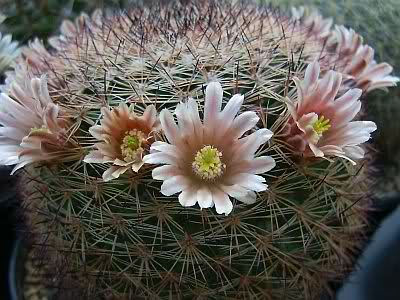First description by Backeberg, The cactus and Succulent Journal of Great Britain 21(4):82. 1959
Body: Solitary, cylindrical, to 35 cm high and 14 cm in diameter, dull green.
Roots: Fibrous.
Sap: With latex.
Tubercule: Pyramidal, 12 mm long, 10 mm wide, firm.
Axil: Naked at first, later felty like.
Radial spine: 20 - 23, 4 - 8 mm long, reddish white with darker tip, irregular radiating, stiff bristle-like to needle-like, straight or curved, the collateral the longest.
Central spine: 4 - 7, sometimes 10, 4 - 8 mm long, needle - like, straight, thicker at base, greyish brown, brown to black with darker tips.
Flower: Bell shaped, dull pink to yellowish brown, to 20 mm long and in diameter.
Fruit: Club-shaped, carmine, 25 mm long and 8 mm wide.
Seed: Brown, club-shaped, 1,2 mm long and 0,6 mm wide. Hilum small and basal.
Habitat Substrate: Under bushwood, in stony and sandy soil with lots of humus.
Geographic Distribution: Mexico, Durango, near Cuencame. Altitude 1600 - 1700 m.
Comments: Pachycylindrica has more spines, darker body, different color of flowers and more cilindrical growth than grusonii.
Bibliography: AfM - LBS Lieferung 09/93 Linzen

